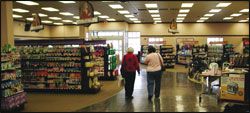Publication
Article
Pharmacy Times
The Showroom Floor: Front-End Retail Strategies for Today's Economic Climate
Author(s):
In today's economy, pharmacies must consider growth strategies and avenues to drive traffic into their stores and increase revenues.
Ms. Heinze is a freelance writer based in Vancouver, British Columbia.
Undeniably, for anyone in retailthese days, it is touch andgo—although consumers arestill spending, they are demandingthat their dollars go further. Impulsebuys are no longer so impulsive, andlarge purchases have, in many cases,been put on hold. Among the retailestablishments out there, pharmaciesare arguably in an enviable position—whether the economy is strong orweak, individuals still need their medicine,which drives traffic through thefront end of the store.

Still, pharmacies are not entirelyrecession-proof, requiring owners to bewise in their front-end retail strategies.Although the temptation may be to cutback and batten down the hatches forthe rough ride ahead, the risk is thatif the store appears too sparse, theowner may be projecting an image thatis detrimental to the pharmacy's overallwell-being.
"The front end of your store is lessthan 10% of your business, but it is 90%of your image," says Gabe Trahan, anindependent consultant and director ofretail services at Burlington Drug inGeorgia, Vermont. "Independent pharmacieshave got to control their inventoryin a better way."
He argues that carrying 1 or 2 unitsof each item sends the message that theproduct is so expensive that even thepharmacy itself cannot afford to stockit. "I fear that, in this economy, theindependents and even the chains aregoing to cut back on inventory, whichmakes it look like you are almost outof business." If your front end is poorlystocked, he challenges, why would customersbelieve that the situation is anybetter behind the prescription counter?
For independent pharmacies, theitems that are often the most difficultto move are the "B" of HBA (healthand beauty aids): oral hygiene, skincare, deodorant, and hair care products,which see considerable markdownsin the big boxes. Trahan argues thatindependent pharmacies should reducetheir prices in line with what the largerchains are offering in an effort to keepthe customer in the store.
"You are never going to get rich sellingHBA, but if you are just a little highon the stuff that you do not sell muchof, you are telling your customer: ?Getyour prescription filled here, but go andget your toothpaste somewhere else,'"he says. Chances are, the retailer thatis selling toothpaste at a lower priceprobably fills prescriptions as well."Someday, that person is going to be sobusy that they are going to see what thecompetition can do on a prescription."
Trahan advises pharmacies to assesstheir least successful departments and,on the price-sensitive items (such astoothpaste and hair care), reduce theprice—even if this means cutting intoyour margin. "You are not selling it anyway—you are chasing people to otherpeople's stores," he says. "This is a lossleader that actually keeps people in yourstore." Instead of adding departmentssuch as photo developing or expandinggift departments that have little todo with health care, he urges pharmaciesto be more strategic on pricing theproductsthey carry already—and haveknowledge about. "The front end maynot be a big part of your business, butit is a big part of your image. If the frontend is slightly higher-priced than moststores, then it is going to be tough torecruit a new Rx customer, becausethey are going to think you are expensive,regardless of whether or not thereis a third-party payer."

If you believe that expansion in someareas is necessary, examine what yourcustomers' needs are: plenty of potentialexists to develop comprehensivedepartments dedicated to diseases suchas diabetes, arthritis, and bone density."Instead of being a supplier, pharmacieshave to become a partner to their customers,"Trahan says. "Our clients arelooking for more than just getting theirprescriptions filled. If you say to them,?let us be a partner with you and yourdoctor,' it will be a big attraction."
Medicine Shoppe International isendeavoring to do this by maintaininga solid focus on patient care. The company'sspecialty centers concentrate onspecific disease states, such as diabetes,as well as home health care. "We are tryingto make disease state managementmore prominent in our stores," explainsMark Kenkel, Medicine Shoppe's directorof OTC, adding that these are someways in which the organization can differentiateitself from the larger chains."We understand who our patients areand what the age of the general populationthat comes into our store is.Demographics play a big part of it; weneed to offer these specialty care itemsthat are going to differentiate us fromthe big boxes."
Another way that pharmacies aredifferentiating themselves is by establishingin-store clinics to drive trafficthrough the store—an effort that MaryKate Scott, principal at Scott & Co Inc,a consulting firm based in Marina DelRey, California, says is very much in alliancewith the current economy. "If youthink about the rising health care costsand increasing interest of consumers intheir own health care, it is no surprisethat the consumer likes and prefers theretail clinic," she says.
Although the construction of an in-storeclinic may seem like a considerableinvestment—especially in a downeconomy—independent retailers havethe option of outsourcing the service toa retail clinic operator or a health careprovider, such as a hospital system."If you are an independent pharmacyowner with 1 or 2 stores, it is probablypretty challenging to set this up on yourown," says Scott. "You will probablysee greater success by working with apartner—whether that is a retail clinicoperator or a hospital." She adds, however,depending on the organization,it is possible for an independent drugstoreowner to set one up and staff it.Regardless of which business modelpharmacies adopt, it is important toassess why the store would benefitfrom a clinic—would it increase visitsfrom regular customers or attract newones?
Scott argues that a large chance existsthat the store would benefit from a clinic.Developments such as consumer-drivenhealth care, flexible spending accounts,and higher deductibles on health insuranceplans have consumers taking morecontrol over their health and wellnessexpenditures. "They are taking a muchmore active role in how they think aboutspending money on prescriptions, onOTC products, and how they managevisits to health care professionals," Scottsays. In doing this, individuals are turningto their pharmacies for advice onwhat health care options are most effective,both in terms of patient outcomeand cost.
"That is why we have seen genericprescriptions go up, flexible spendingaccounts being used, and retail clinicsbeing used," Scott says. "The consumeris saying, ?Help me figure out when Ireally need to buy the brand prescription,the generic prescription, or whenthere is an OTC product that could giveme self-diagnosis, or help me understandwhen I can use a retail clinic so that I canget a great service at a fair price.'"
In an industry where pretty muchevery retail establishment sells the sameproducts, pharmacies should concentrateon service—the factor that setsthem apart from the competition. Notonly does this differentiate one storefrom another, Scott says, but it alsostrengthens the organization's relationshipwith its consumers. "You get stronger,deeper customer relationships whenyou combine service with product."







